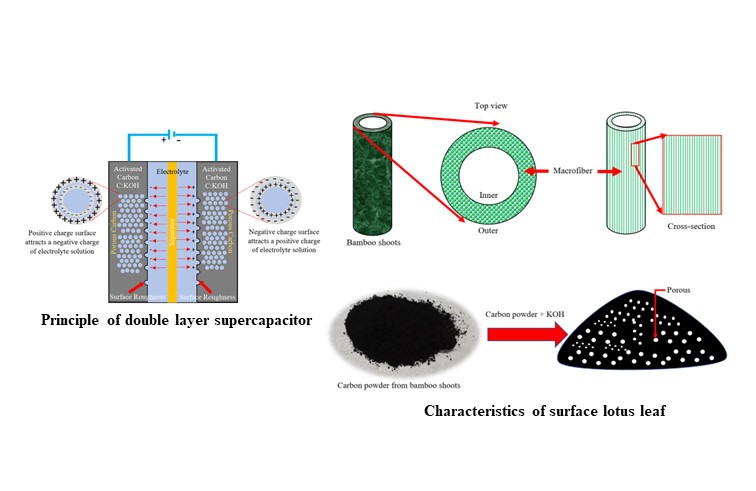Activated carbon synthesized from bamboo shoots for supercapacitor application
DOI:
https://doi.org/10.55674/cs.v15i1.247051Keywords:
activated carbon, bamboo shoots, supercapacitor, KOH activation, carbon electrodeAbstract
Carbon powder was synthesized from bamboo shoots by chemical activation. The porous carbon powders were activated by potassium hydroxide (KOH) with a ratio of carbon powder (C) and KOH (C : KOH) of 1 : 1, 1 : 2, 1 : 3, and 1 : 4 by weight, respectively. Structure, morphological properties, and the porosity of activated carbon powders were investigated by XRD, EDX, SEM, and BET.
The electrochemical performances were measured by charge/discharge (CD) and cyclic voltammetry (CV) techniques. Specific surface areas increased to 1,017, 1,162, 1,257, and 1,012 m2 g−1 for C : KOH ratios of 1 : 1, 1 : 2, 1 : 3, and 1 : 4, respectively. Specific capacitances were 11.30, 26.60, 50.50, and 40.50 F g–1 for the C : KOH ratios of 1 : 1, 1 : 2, 1 : 3, and 1 : 4, respectively. The activated carbon electrode with a C: KOH ratio of 1 : 3 sintered at 600 °C displayed the highest specific capacitance value of 50.5 F g–1. It should be a good candidate material for high-performance supercapacitor electrodes.
HIGHLIGHTS
- The synthesis carbon powder from natural material is bamboo with the activated chemical construction method by the stimulation with KOH into the carbon powder in C : KOH ratio was 1 : 1, 1 : 2, 1 : 3 and 1 : 4.
- When increasing the ratio of carbon to KOH will have a lot porous sizes spread on the surface of carbon.
GRAPHICAL ABSTRACT

References
B.K. Kim, S. Sy, A. Yu, J. Zhang, Electrochemical Supercapacitors for Energy Storage and Conversion, Handbook of Clean Energy Systems, John Wiley & Sons, Ltd., 2015.
J. Liu, J. Wang, C. Xu, H. Jiang, C. Li, L. Zhang, J. Lin, Z.X. Shen, Basic Principles, Analytical Methods, and Rational Materials Design, Adv. Sci. 5 (2018) 1 – 19.
P.K. Panda, A. Grigoriev, Y.K. Mishra, R. Ahuja, Progress in supercapacitors: roles of two dimensional nanotubular materials, Nanoscale Adv. 2 (2020) 70 – 108.
H. Ji, X. Zhao, Z. Qiao, J. Jung, Y. Zhu, Y. Lu, L.L. Zhang, H. Allan, M. Donald, S.R. Ruoff, Capacitance of carbon-based electrical double-layer capacitors, Nat. Commun. 5(1) (2014) 1 – 7.
Y. Show, Electric Double-Layer Capacitor Fabricated with Addition of Carbon Nanotube to Polarizable Electrode, J. Nanomater. (2012) 1 – 8.
S.A. Banu, S. Nagarani, M. Kirubha, Preparation of Low Cost Activated Carbon Adsorbents from Natural Sources, Int. J. Eng. Tech. Sci. & Re. 3(4) (2016) 43 – 46.
L. Suna, Z. Zhao, Y. Suna, X. Wang, X. Liu, Y. Yang, J. Qiu, Activated coal-based graphene with hierarchical porous structures for ultrahigh energy density supercapacitors, Diam. Relat. Mater. 106 (2020) 107827.
Y. Ping, J. Han, J. Li, B. Xiong, P. Fang, C. He, N, S co-doped porous carbons from natural Juncus effuses for high performance supercapacitors, Diam. Relat. Mater. 100 (2019) 107577.
N. Sharma, N. Mishra, M. Sharon, M. Sharon, High performance supercapacitor using porous carbon nanomaterial from corn cob, AIP Conf. Proc. 1538 (2013) 219 – 223.
S. Li, K. Han, P. Si, J. Li, C. Lu, High–performance Activated Carbons Prepared by KOH Activation of Gulfweed for Supercapacitors, Int. J. Electrochem. Sci. 13 (2018) 1728 – 1743.
K.Y. Foo, B.H. Hameed, Porous structure and adsorptive properties of pineapple peel based activated carbons prepared via microwave assisted KOH and K2CO3 activation. Micropor. Mesopor. Mater. 148(1) (2012) 191 – 195.
M. Fujishige, I. Yoshida, Y. Toya, Y. Banba, Preparation of activated carbon from bamboo-cellulose fiber and its use for EDLC electrode material. J. Environ. Chem. Eng. 5(2) (2017) 1801 – 1808.
B. Lu, L. Hu, H. Yin, X. Mao, W. Xiao, D. Wang, Preparation and application of capacitive carbon from bamboo shells by one step molten carbonates carbonization, Int. J. Hydrog. Energy 41(41) (2016) 18713 – 18720.
H. Saygili, High surface area mesoporous activated carbon from tomato processing solid waste by zinc chloride activation: process optimization, characterization and dyes adsorption. J. Clean. Prod. 1(113) (2016) 995 – 1004.
C.S. Yang, Y.S. Jang, H.K. Jeong, Bamboo-based activated carbon for supercapacitor applications, Curr. Appl. Phys. 14(12) (2014) 1616 – 1620.
P.H. Ying, H.H. Chia, C.H. Hsing, W.W. Jia, Optimization of highly microporous activated carbon preparation from Moso bamboo using central composite design approach, J. Taiwan. Inst. Chem. Eng. 50(2) (2015) 266 – 275.
G. Zhang, H. Chen, W. Liu, D. Wang, Y. Wang, Bamboo chopsticks-derived porous carbon microtubes/flakes composites for supercapacitor electrodes, Mater. Lett. 185 (2016) 359 – 362.

Downloads
Published
How to Cite
Issue
Section
Categories
License
Copyright (c) 2023 Creative Science

This work is licensed under a Creative Commons Attribution-NonCommercial-NoDerivatives 4.0 International License.








